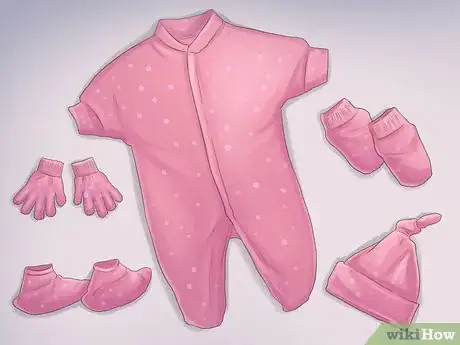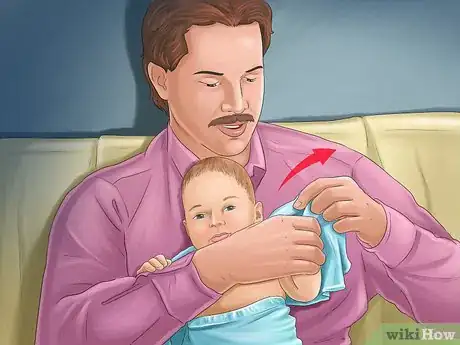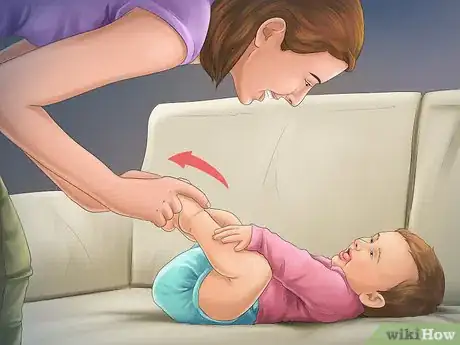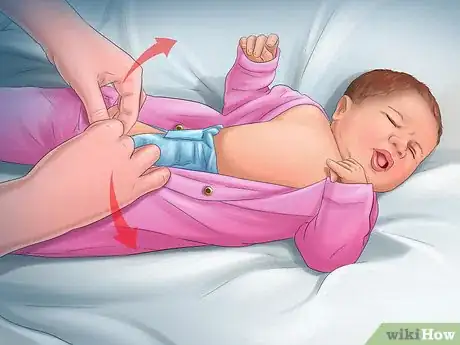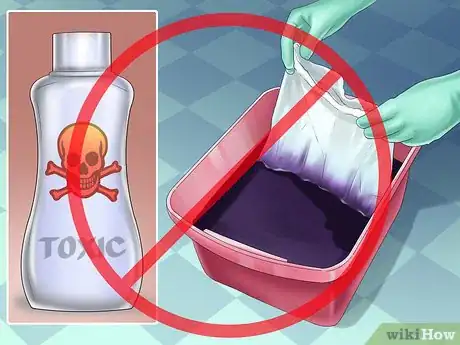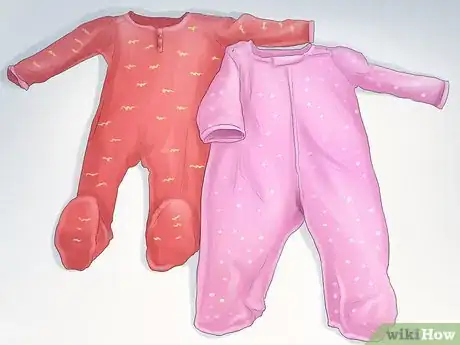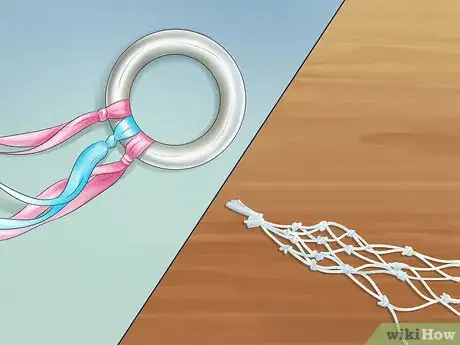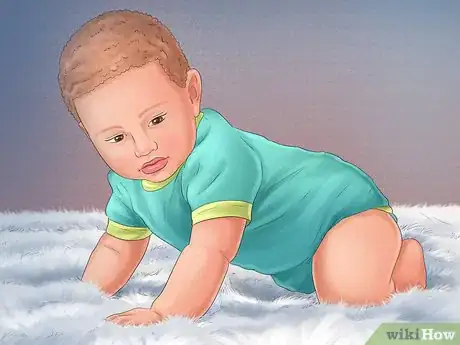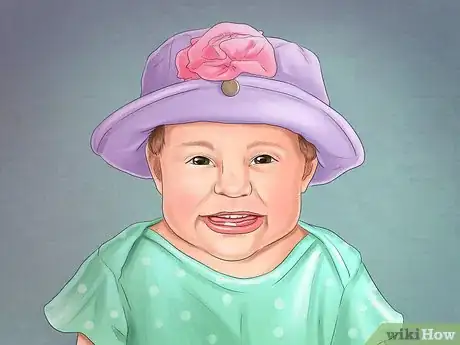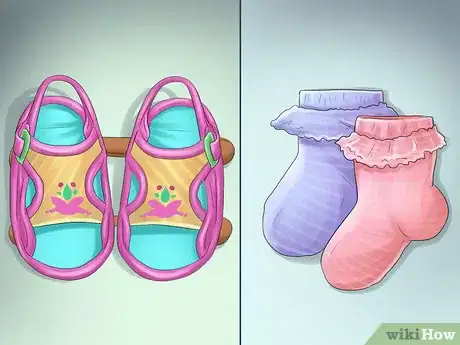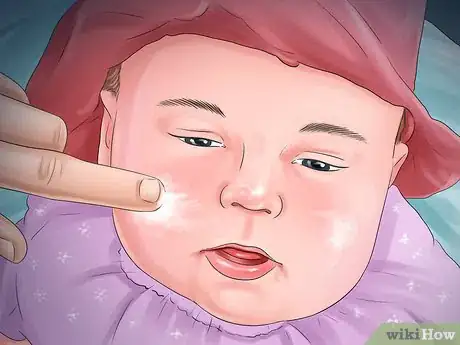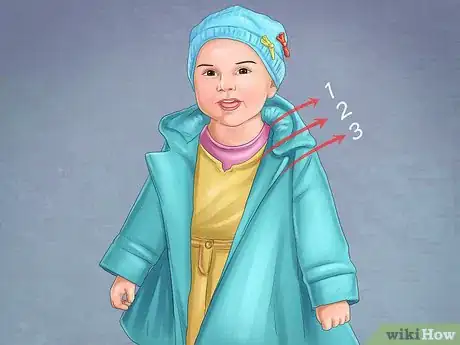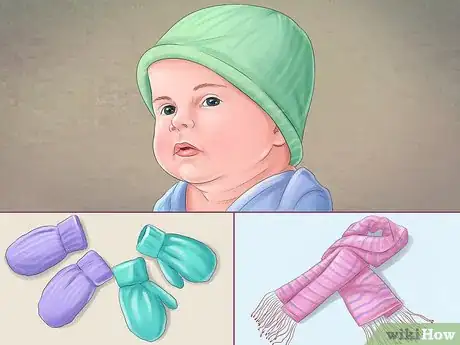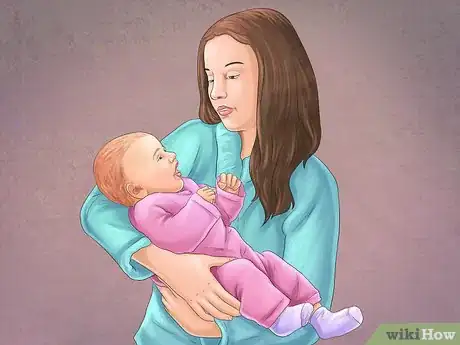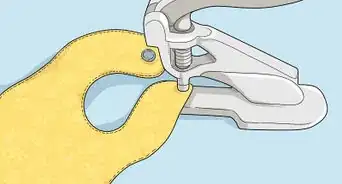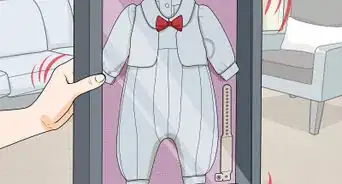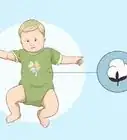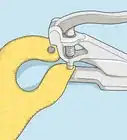This article was co-authored by Andrea Rudominer, MD, MPH. Dr. Andrea Rudominer is a board certified Pediatrician and Integrative Medicine Doctor based in the San Francisco Bay Area. Dr. Rudominer has over 15 years of medical care experience and specializes in preventive health care, obesity, adolescent care, ADHD, and culturally competent care. Dr. Rudominer received her MD from the University of California, Davis, and completed a residency at the Lucile Packard Children's Hospital at Stanford University. Dr. Rudominer also has an MPH in Maternal Child Health from the University of California, Berkeley. She is a Member of the American Board of Pediatrics, a Fellow of the American Academy of Pediatrics, a Member and Delegate of the California Medical Association, and a Member of the Santa Clara County Medical Association.
There are 15 references cited in this article, which can be found at the bottom of the page.
This article has been viewed 35,302 times.
If your baby is uncomfortable, she may act fussy or irritable. Her delicate skin and undeveloped body are extra sensitive to textures and chemicals.[1] Overdressing can lead to overheating, and underdressing can leave your baby susceptible to cold, or even frostbite![2] To make getting your bundle of joy into clothing less of a chore, there are a few tricks you can use which, when combined with a comfy outfit, will result in a well protected, happy, dressed baby.
Steps
Putting on Clothing
-
1Lay out your baby's clothes ahead of time. This can be especially helpful if your child likes to wiggle about while you're dressing her. Be sure you have laid out her clothing and that it's well within reach to make the dressing process less of a hassle.
- Clothing that uses snaps to fasten the garment in place can make the dressing process much easier on you.[3]
-
2Support your baby while dressing. With very young infants, you will need to provide additional head support while dressing. This can be done by holding her in your lap while putting on clothing and allowing your legs to support her head.[4]Advertisement
-
3Pull limbs instead of pushing. Sleeves easily tangle around your young one's limbs. This can make the everyday task of dressing your child frustrating, but you should avoid pushing her tiny arms and legs into sleeves, as this can cause her to bend or twist a limb painfully.
- Put your hand through the sleeve from the outside, take your baby's limb gently in your hand, and pull it through.[5]
-
4Make room for the head. Young infants have little muscular control and require your support, particularly for the neck and head. When trying to fit her head into an article of clothing, stretch the neckline to give her as much clearance as she needs.
- You should always try to pull clothing onto and off of your baby quickly, as blocked breathing can cause your little one to panic.[6]
-
5Remove clothing in phases. Remove your baby's limbs from each sleeve individually while supporting her by the back of the head. Once the limbs are free, stretch the neckline wide enough so that it clears her chin and face. Then, simply lift the garment off.[7]
Choosing Clothing
-
1
-
2Safeguard your baby against chemicals. Some dyes and fabric treatments are quite toxic, and your young one's developing body might be vulnerable to these.[11] [12] You may need to look up clothing information before purchasing it. This will help you to determine whether or not the dyes and appliques used on it are nontoxic.
- You can lessen the risk of exposing your child to dangerous chemicals by buying clothing from secondhand stores and dressing her in hand-me-downs. Repeated washings can diminish the chemicals in the clothing
- Avoid wrinkle free, anti-microbial, and stain resistant labels.
- Wash new clothing multiple times to remove residual and manufacturing chemicals.
-
3Optimize with snaps and zippers. Young children will need to have diapers changed frequently, and snaps in the crotch of your baby's one-piece will make this task much easier. Zippers or snaps down the front can also aid you in your child dressing responsibilities.[13]
-
4Avoid choking hazards. As cute as you might think ribbons, knotted strings, and fabric accents will look on your baby, rough play or daily wear can tear these loose. If this occurs, your child could put a ribbon in her mouth and choke on it.[14]
Dressing for Warm Weather
-
1Prioritize clothing to diminish heat. In a heat wave, your baby can easily become overheated and fussy. Choose lightweight, loose fitting clothing that breathes to help prevent this.[15] You should also avoid dark colors, as these absorb heat and can contribute to your child's overheating.[16] [17]
- A good rule of thumb is to dress your baby in one layer more than you'd feel comfortable in.[18]
-
2Make use of hats. An umbrella or tree can keep the sun's damaging rays from leaving your child sunburned, but sometimes these options aren't available. A wide brimmed hat can keep your baby from getting too much sun while allowing her to play outside with her friends.[19]
-
3Bring extra shoes and socks. Your baby might be different, but many young children prefer to take off shoes and socks in warm weather. The small size of these garments means that they can be easily misplaced. Having an extra pair on hand can be a lifesaver when play time's over and you're ready to redress your child and go.[20]
-
4Apply sunscreen to your baby's skin. While you might think that your child's clothing should keep her sufficiently guarded against the sun, but an average cotton t-shirt is only rated at an SPF of five![21] Make sure she is wearing sunscreen before going out to play in warm, sunny weather.
-
5Use well-ventilated baby carriers. The heat of the day can combine with your body heat to make the enclosed space of a baby carrier uncomfortable for your little one. Carriers made from nylon, or other light fabrics, can disperse this heat.[22]
- If you notice that your child is looking more flushed than normal, she could potentially be overheating. Remove her from the carrier right away, and seek out a cooler location.[23]
Dressing for Cold Weather
-
1Put your baby in one more layer than you'd wear yourself. Especially if you live in areas that can be particularly cold, you're probably accustomed to wearing multiple layers to keep warm. It's generally a good idea to dress your baby in one more layer than you are wearing yourself.[24]
- You'll also want to bring along an extra sweater or blanket, just in case your child needs some additional warmth.
- On cool nights, consider dressing your baby in a wearable cotton sleep sack. However, avoid using blankets or loose clothing, as they can cause a risk for suffocation.[25]
- In exceptionally cold weather, you should opt for layers over a single "super warm" garment.
-
2Be careful not to overbundle.[26] Babies learn how to regulate their body temperature very quickly and may not need as many layers of warm clothing as you think.[27] Feeling constricted or uncomfortably hot due to too many clothes can cause fussiness in your child. Some doctors assert that many babies are overdressed, citing the custom of many northern European countries to allow children out in the cold without heavy bundling with no measurable negative impact as proof.[28]
- Check your child regularly while you learn the most comfortable amount of layers for her in the cold. Every child is different, and some will require more bundling than others.[29]
- Feel your baby's skin temperature to see if she's overheating or chilled.[30]
- Being dressed in too many layers can lead to overheating or heat rash, even in cold weather.[31]
-
3Cover your baby's extremities. Your child could easily develop frostbite or frostnip on the head, face, ears, hands, and/or feet if she is not properly dressed for the cold.[32] Frostbite is where the skin gets too cold and freezes, and can be very dangerous to your child's health. To prevent this from happening, be sure she is fully equipped with winter gear, like:
- Hat
- Waterproof mittens or gloves
- Scarf
- Winter boots/booties
-
4Watch for warning signs that your child is cold. If your baby's skin is cold to the touch, a blueish color develops in the skin, or she is crying or complaining more than usual, your child might need a break from the cold. Spend some time indoors and think about adding a layer of clothing or a fresh, dry pair of gloves to her winter clothes.[33]
- Look into more detailed advice on dressing your baby in winter, for indoors, outdoors and at night.
Expert Q&A
-
QuestionHow can you prevent a baby from getting too hot in the summertime?
 Julie Wright, MFTJulie Wright is a Marriage and Family Therapist and the co-founder of The Happy Sleeper, which offers sleep consulting and online baby sleep classes. Julie is a licensed psychotherapist specializing in babies, children, and their parents, and the co-author of two best selling parenting books (The Happy Sleeper and Now Say This) published by Penguin Random House. She created the popular Wright Mommy, Daddy and Me program in Los Angeles, California, which provides support and learning for new parents. Julie's work has been mentioned in The New York Times, The Washington Post, and NPR. Julie received her training at the Cedars Sinai Early Childhood Center.
Julie Wright, MFTJulie Wright is a Marriage and Family Therapist and the co-founder of The Happy Sleeper, which offers sleep consulting and online baby sleep classes. Julie is a licensed psychotherapist specializing in babies, children, and their parents, and the co-author of two best selling parenting books (The Happy Sleeper and Now Say This) published by Penguin Random House. She created the popular Wright Mommy, Daddy and Me program in Los Angeles, California, which provides support and learning for new parents. Julie's work has been mentioned in The New York Times, The Washington Post, and NPR. Julie received her training at the Cedars Sinai Early Childhood Center.
Parenting & Baby Sleep Specialist It's a myth that babies need to be wrapped, double wrapped, heated, or overdressed. This can even be a safety issue, too. Try dressing your baby in light clothing to keep them as cool as possible, and keep the air nice and cool either with an air conditioner or fans.
It's a myth that babies need to be wrapped, double wrapped, heated, or overdressed. This can even be a safety issue, too. Try dressing your baby in light clothing to keep them as cool as possible, and keep the air nice and cool either with an air conditioner or fans. -
QuestionWhat clothes should my baby wear for sleeping?
 Andrea Rudominer, MD, MPHDr. Andrea Rudominer is a board certified Pediatrician and Integrative Medicine Doctor based in the San Francisco Bay Area. Dr. Rudominer has over 15 years of medical care experience and specializes in preventive health care, obesity, adolescent care, ADHD, and culturally competent care. Dr. Rudominer received her MD from the University of California, Davis, and completed a residency at the Lucile Packard Children's Hospital at Stanford University. Dr. Rudominer also has an MPH in Maternal Child Health from the University of California, Berkeley. She is a Member of the American Board of Pediatrics, a Fellow of the American Academy of Pediatrics, a Member and Delegate of the California Medical Association, and a Member of the Santa Clara County Medical Association.
Andrea Rudominer, MD, MPHDr. Andrea Rudominer is a board certified Pediatrician and Integrative Medicine Doctor based in the San Francisco Bay Area. Dr. Rudominer has over 15 years of medical care experience and specializes in preventive health care, obesity, adolescent care, ADHD, and culturally competent care. Dr. Rudominer received her MD from the University of California, Davis, and completed a residency at the Lucile Packard Children's Hospital at Stanford University. Dr. Rudominer also has an MPH in Maternal Child Health from the University of California, Berkeley. She is a Member of the American Board of Pediatrics, a Fellow of the American Academy of Pediatrics, a Member and Delegate of the California Medical Association, and a Member of the Santa Clara County Medical Association.
Board Certified Pediatrician & Integrative Medicine Doctor That really depends on the time of year. However, a good rule of thumb is to dress your baby in one extra layer than you'd feel comfortable in. Bundling too much can lead to overheating and can cause a heat rash. When the weather is cool, dress your baby in a cotton sleep sack to keep them warm. You can also put them in a beanie to keep their head warm. However, avoid blankets or loose clothing, as that can cause a risk for suffocation.
That really depends on the time of year. However, a good rule of thumb is to dress your baby in one extra layer than you'd feel comfortable in. Bundling too much can lead to overheating and can cause a heat rash. When the weather is cool, dress your baby in a cotton sleep sack to keep them warm. You can also put them in a beanie to keep their head warm. However, avoid blankets or loose clothing, as that can cause a risk for suffocation.
References
- ↑ http://lesstoxicguide.ca/index.asp?fetch=babycare
- ↑ Julie Wright, MFT. Childcare Specialist. Expert Interview. 6 March 2020.
- ↑ http://alphamom.com/pregnancy/baby-101-how-to-dress-a-newborn/
- ↑ https://www.healthychildren.org/English/ages-stages/baby/diapers-clothing/Pages/Dressing-Your-Newborn.aspx
- ↑ https://www.healthychildren.org/English/ages-stages/baby/diapers-clothing/Pages/Dressing-Your-Newborn.aspx
- ↑ http://www.webmd.com/baby/choosing-baby-clothes
- ↑ https://www.healthychildren.org/English/ages-stages/baby/diapers-clothing/Pages/Dressing-Your-Newborn.aspx
- ↑ http://www.healthguidance.org/entry/11489/1/Why-Cotton-Is-the-Choice-for-Babies.html
- ↑ http://www.webmd.com/baby/choosing-baby-clothes?page=2
- ↑ http://www.themamamaven.com/2013/03/18/what-the-best-baby-blanket-fabric-for-your-little-ones/
- ↑ http://totalhealthmagazine.com/Allergies-Asthma/Consumers-Beware-Toxins-Lurking-in-Your-Clothing.html
- ↑ http://lesstoxicguide.ca/index.asp?fetch=babycare
- ↑ http://alphamom.com/pregnancy/baby-101-how-to-dress-a-newborn/
- ↑ https://www.healthychildren.org/English/ages-stages/baby/diapers-clothing/Pages/Dressing-Your-Newborn.aspx
- ↑ Julie Wright, MFT. Childcare Specialist. Expert Interview. 6 March 2020.
- ↑ http://www.parents.com/baby/care/newborn/making-baby-comfortable-in-summer-heat/
- ↑ http://www.babycenter.com/0_heat-stroke_416.bc
- ↑ Andrea Rudominer, MD, MPH. Board Certified Pediatrician & Integrative Medicine Doctor. Expert Interview. 6 May 2020.
- ↑ http://alphamom.com/pregnancy/baby-101-how-to-dress-a-newborn/
- ↑ http://www.fisher-price.com/en_US/parenting-articles/life-with-baby/how-to-dress-baby-for-any-weather
- ↑ http://www.parents.com/baby/care/newborn/making-baby-comfortable-in-summer-heat/
- ↑ http://www.parents.com/baby/care/newborn/making-baby-comfortable-in-summer-heat/
- ↑ http://www.babycenter.com/0_heat-stroke_416.bc
- ↑ Andrea Rudominer, MD, MPH. Board Certified Pediatrician & Integrative Medicine Doctor. Expert Interview. 6 May 2020.
- ↑ Andrea Rudominer, MD, MPH. Board Certified Pediatrician & Integrative Medicine Doctor. Expert Interview. 6 May 2020.
- ↑ http://alphamom.com/pregnancy/baby-101-how-to-dress-a-newborn/
- ↑ Julie Wright, MFT. Childcare Specialist. Expert Interview. 6 March 2020.
- ↑ http://www.fisher-price.com/en_US/parenting-articles/life-with-baby/how-to-dress-baby-for-any-weather
- ↑ http://www.healthywomen.org/content/article/10-winter-weather-tips-bundling-baby?context=healthcenter/53&context_title=53
- ↑ http://www.healthywomen.org/content/article/10-winter-weather-tips-bundling-baby?context=healthcenter/53&context_title=53
- ↑ Andrea Rudominer, MD, MPH. Board Certified Pediatrician & Integrative Medicine Doctor. Expert Interview. 6 May 2020.
- ↑ http://kidshealth.org/parent/firstaid_safe/emergencies/frostbite.html
- ↑ http://www.fisher-price.com/en_US/parenting-articles/life-with-baby/how-to-dress-baby-for-any-weather

